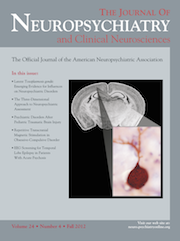Lithium Plus ECT for Mania in 90 Cases: Safety Issues
To the Editor: The concurrent use of lithium and electroconvulsive therapy (ECT) is subject to controversy.1,2 Whereas lithium discontinuation may result in rebound mania, sparse observational studies and case reports support the rejection of their concomitant administration, because of an increased risk for prolonged apnea and neurological side effects.3 So far, only one small (N=56), controlled experimental study4 assessed the risks of combining lithium and ECT, with no severe adverse outcomes. Managing bipolar disorder often requires much beyond available evidence to keep a patient stable, or alive. Since no well-designed studies support the concomitant use of lithium and ECT, patients and doctors are exposed to safety issues.
In the recent past, we have published a retrospective study primarily aimed at investigating inpatient treatment practices for mania.5 ECT was used in one-third of 425 admissions for mania (bilateral electrodes, sinusoidal device, anesthesia with succinylcholine and thiopental). Lithium was frequently used concurrently with ECT (in 63% of the cases; N=90), as well as antipsychotics (in 82%), anticonvulsants (31%), antidepressants (4%), and benzodiazepines (47%). Deaths were neither reported with the lithium/ECT association, nor in a non-lithium ECT subgroup (N=51). Length of stay was not significantly altered because of lithium (20.3 [12.9] versus 21.1 [9.12] days) or of other concomitant medication. The average number of ECT sessions was similar in patients with lithium (5.6 [2.5]) and without lithium (6.2 [2.4]). The average number of internal-medicine referrals during admissions was lower in the ECT+lithium subgroup (1.9 [1.9]) than in the non-lithium ECT subgroup (2.8 [2.8]; p=0.02), and the number of psychiatric calls was statistically similar in patients receiving concomitant lithium (5.3 [6.6]) and not receiving it (6.7 [7.5]). Post-ECT length of stay was not influenced by the concomitant use of lithium (3.5 [6.4] versus 2.9 [5.2]). However, cognitive side effects were not directly assessed in that study.
On this case series of 90 mania patients who received lithium+ECT, severe unfavorable outcomes were absent. More subtle adverse effects of this interaction could not be evidenced because of the retrospective study design, and lithium levels were not gathered. However, the naturalistic approach adds real-life evidence to this debate.
Currently improved ECT practices, including comprehensive pre-ECT evaluation with neuroimaging, ECT monitoring, optimizing energy use, and targeting for lower lithium serum levels contributes to improve the safety of the lithium+ECT association.
1 : Lithium and electroconvulsive therapy: adversaries, competitors, allies? Acta Psychiatr Scand 1991; 84:435–438Crossref, Medline, Google Scholar
2 : Complications of concurrent lithium and electroconvulsive therapy: a review of clinical material and theoretical considerations. Biol Psychiatry 1988; 23:595–601Crossref, Medline, Google Scholar
3 : The Practice of Electroconvulsive Therapy: Recommendations for Treatment, Training, and Privileging. Washington, DC, 2001Google Scholar
4 : A prospective comparative study of interaction between lithium and modified electroconvulsive therapy. World J Biol Psychiatry 2011; 12:149–155Crossref, Medline, Google Scholar
5 : Naturalistic evaluation of inpatient treatment of mania in a private Brazilian psychiatric hospital. Rev Bras Psiquiatr 2003; 25:72–77Crossref, Medline, Google Scholar



